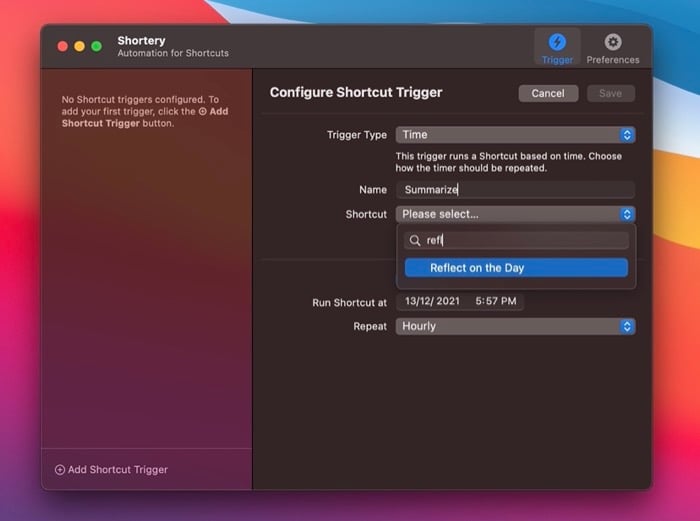In Summary
- Apple introduced the desktop version of Shortcuts with the launch of macOS Monterey earlier this year.
- However, unlike its iOS or iPadOS counterpart, the Mac Shortcuts app doesn’t offer automation functionalities to trigger shortcuts automatically.
- Shortery bridges this gap by offering you a few different triggers that you can use to run Mac shortcuts automatically.
Shortcuts (formerly Workflow) is a popular task automation and scripting app among iPhone and iPad users. Following its popularity—and in response to Mac users’ requests, Apple introduced the desktop version of Shortcuts with the launch of macOS Monterey earlier this year.
However, as of writing this, Apple doesn’t offer automation triggers on the Mac Shortcuts app as it does with its iOS or iPadOS equivalent, leaving users with no choice but to run shortcuts manually on their Mac.
Fortunately, there’s a way around this, and it involves using an app called Shortery. In this guide, we’ll check out Shortery and list down the instructions to use it to automate your shortcuts on the Mac Shortcuts app.
What Is Shortery?
Shortery is an all-new shortcut automation app for Mac on macOS Monterey. It works with the Mac Shortcuts app and lets you execute your Mac shortcuts automatically using various triggers, so you don’t have to run them manually.
By doing so, Shortery extends the ability of the Mac Shortcuts app, which lacks the Automation tab, to be used in a somewhat similar manner as the Shortcuts app on iOS and iPadOS. We say somewhat because, as of writing this, Shortery offers only a handful—seven to be precise—of triggers to run shortcuts, which is way lower than the trigger options on Shortcuts iOS or iPadOS apps.
For example, you can set a trigger for the Reflect on the Day shortcut in the Mac Shortcuts app to run at a specific time of day so you can keep a record of what you accomplished on the day and what’s on your agenda for tomorrow.
How to Use Shortery on Mac
Shortery is a third-party app for Mac. So to use it, you first need to download it on your Mac. Click on the link below to visit the App Store and download Shortery.
Once Shortery is installed, launch it. You can do this by either opening Spotlight Search (Command + Space bar) and searching for Shortery or going into the Launchpad and launching Shortery from there.
As soon as the app opens, it will request access to Finder. Click OK to grant access and proceed.
When Shortery opens, tap on the Trigger tab in the Shortery app window and click on the Add Shortcut Trigger button.
This should open the Configure Shortcut Trigger window on the right pane.
Here, click on the dropdown button next to Trigger Type to open the list of all Shortery triggers. Then, choose the trigger you want to use to run your shortcut automatically from the menu.
Available options include:
- Application: It triggers a shortcut when an app is launched or quit.
- Time: It lets you run a shortcut based on time. You can also choose how often do you want to repeat the timer.
- Wake Up & Sleep: It triggers a shortcut when your Mac goes or sleep or wakes up from sleep.
- Login & Logout: It runs a shortcut when you log in or log out on your Mac.
- Keyboard: It runs a shortcut via a keyboard shortcut from any app on your Mac.
- Appearance: It lets you trigger shortcuts when the appearance (or theme) changes from light to dark or vice-versa.
- Power Status: It triggers a shortcut when you plug in a power adapter to charge your Mac or when the battery level changes.
Once you choose the trigger, tap the Name field and give a name to your shortcut trigger. Next, hit the dropdown button against Shortcut and select the shortcut you want to automate from the list. In case you don’t see the shortcuts list, tap the Reload Shortcut List button to fetch it again.
Check off the checkbox next to Enable Trigger. Now, depending on which trigger you chose, its triggering options and settings will appear in the bottom half of the window accordingly. So set these options to your preference.
When done, hit the Save button to save the shortcut trigger.
Once it’s saved, the shortcut trigger will appear on the left pane. You can click on it anytime to view or change the trigger setting or shortcut. If you ever need to delete it, click on the cross icon next to the trigger name.
If you’re using Shortery’s login trigger to automate the launch of any of your shortcuts, you need to set the app to run at the time of login. For this, while in Shortery, click on the Preferences tab and tick the checkbox next to Start at Login.
Of course, this goes without saying that you need to have Shortery running in the background in order for it to execute shortcuts for you.
Run Shortcuts on Mac Automatically
Being able to trigger shortcuts automatically on your Mac can be an extremely useful feature. The Shortery app unlocks this potential by giving you the ability to choose trigger factors for executing shortcuts automatically on your Mac.
So now, you can find or create new shortcuts in the Shortcuts app and set triggers for them on Shortery. Post which, Shortery will automatically execute them when their triggers occur.
It’s worth noting, however, that we encountered are a few bugs in Shortery at the time of writing this guide. For example, in a few instances, Shortery’s settings weren’t accessible from the menu bar, while in others, we couldn’t restore the app from its minimized state. But given this is the very first version of the app, we can expect these bugs to be fixed via an update soon.
Check out Shortery: Website





